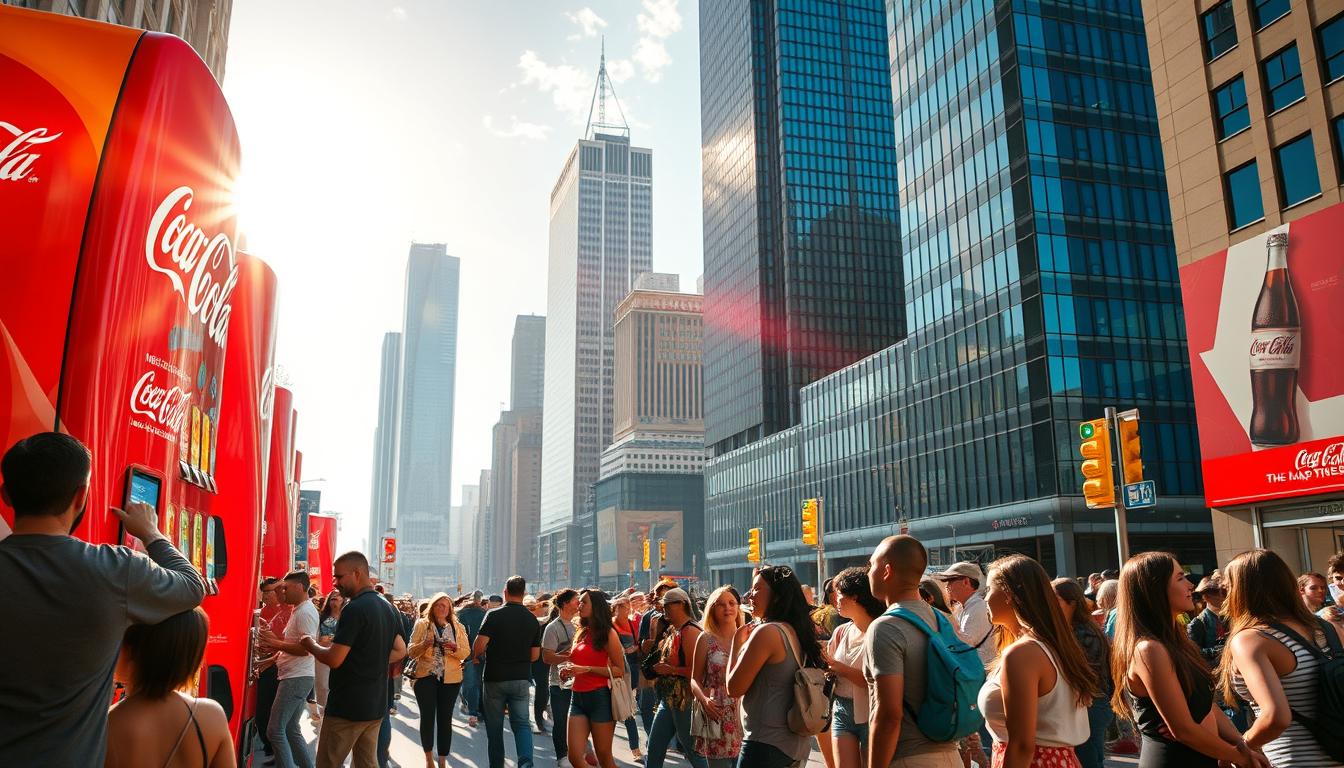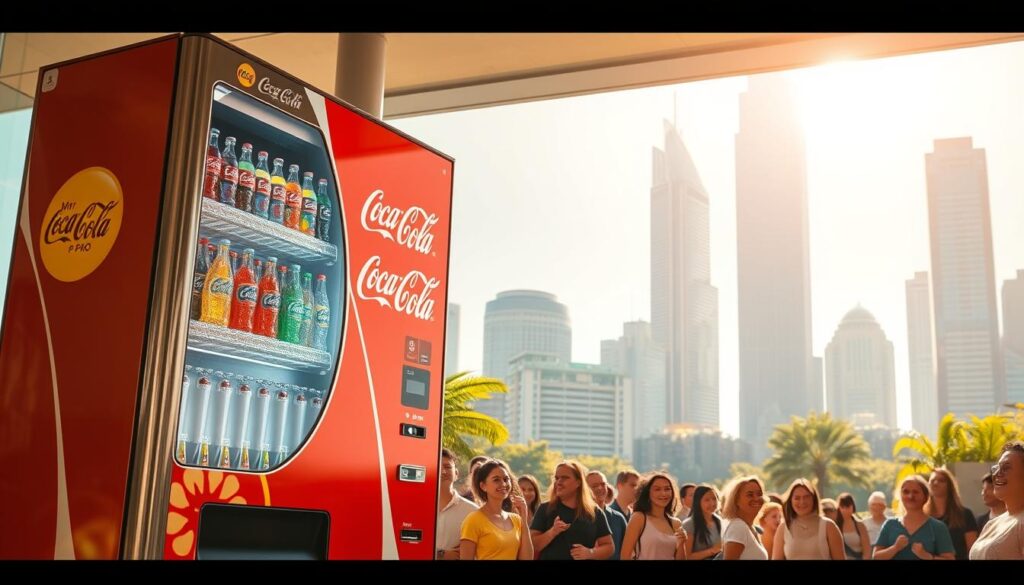
Imagine a vending machine that dispenses not just drinks, but moments of pure joy. In 2010, the Coca-Cola Company launched a revolutionary campaign that would change the face of viral marketing. On January 12, 2010, the Happiness Machine video debuted on YouTube, quickly amassing over 1 million views in a short span. This clever idea harnessed the power of surprise and authenticity, capturing real, unscripted reactions through hidden camera footage.
What made this campaign so groundbreaking? It blended creative spontaneity with genuine expressions of joy, creating a shareable experience that transcended borders. The video’s universal appeal allowed it to resonate with audiences worldwide, turning it into a cultural phenomenon. By focusing on real-life moments, Coca-Cola crafted a narrative that felt personal and relatable, making the brand more approachable and human.
The campaign’s success wasn’t just about the video itself but how it was strategically distributed. Leveraging social media platforms and engagement campaigns, Coca-Cola ensured the video spread like wildfire. This approach not only boosted brand visibility but also reinforced the company’s image as a promoter of happiness and positivity.
As you explore this case study, you’ll discover how the Coca-Cola Happiness Machine became a blueprint for effective viral marketing. Learn how the company’s strategic use of video content, hidden camera techniques, and emotional storytelling created a campaign that remains iconic to this day. For more insights into crafting impactful marketing strategies, visit mrmp.pro/all-services/.
Campaign Background and Objectives
The Coca-Cola Happiness Machine campaign was born from a creative brief that emphasized authentic happiness and human connection. With a limited budget of $60,000, the challenge was to create a video that would achieve viral distribution without paid media support.
Origins and Creative Brief
The campaign’s origins trace back to a simple yet powerful concept: surprise and delight. The creative team was tasked with producing a video that would resonate broadly while staying true to Coca-Cola’s brand values. The brief required a balance between creative and business objectives, ensuring the final product was both engaging and aligned with corporate goals.
Key Business Goals
The primary goals were clear: demonstrate authentic happiness and showcase real human connection. The campaign aimed to generate viral sharing through its genuine and heartwarming moments, captured using hidden camera footage. This approach ensured the content felt personal and relatable, enhancing Coca-Cola’s brand appeal.
| Feature | Details | Objective |
|---|---|---|
| Budget | $60,000 | Produce a viral video without paid media |
| Target | Broad appeal | Ensure universal resonance |
| Method | Hidden camera | Capture authentic reactions |
For more insights into crafting impactful marketing strategies, visit mrmp.pro/e-commerce-seo/.
Coca-Cola Happiness Machine Campaign: In-Depth Analysis
The Coca-Cola Happiness Machine campaign stands out as a masterclass in blending simplicity with authenticity. By focusing on genuine, unscripted moments, the campaign created a video that felt deeply personal and relatable. This approach not only captured the essence of human connection but also ensured the content was shareable across cultures.
Unpacking the Concept and Authenticity
The campaign’s success hinged on its ability to evoke real-life reactions. Using a hidden camera, the video captured spontaneous joy, making viewers feel like they were part of the experience. This raw, unedited footage was then professionally edited to enhance its emotional impact without losing its authenticity.
The strategic use of hidden cameras played a crucial role in capturing authentic emotions. By melding professional editing with unscripted moments, the campaign created a narrative that resonated universally. The simplicity of the concept—a vending machine surprising people—allowed the focus to remain on the genuine reactions, strengthening the emotional appeal for viewers.

The campaign’s relatability stemmed from its focus on real human experiences. The natural expressions of delight and surprise made the video memorable and shareable. This authenticity was further supported by cultural and personal connections, ensuring the campaign’s message transcended borders. For more insights into how emotional storytelling impacts marketing, visit this resource.
Production Techniques and Viral Strategy
The Coca-Cola Happiness Machine campaign’s success can be attributed to its innovative production techniques and strategic distribution. By blending professional production quality with a hidden camera style, the video captured authentic, unfiltered reactions that resonated deeply with viewers.
Hidden Camera Aesthetics and Real Reactions
The use of hidden cameras was pivotal in capturing genuine, spontaneous joy. This approach ensured that the reactions were raw and unscripted, making the video feel more personal and relatable. The balance between professional editing and the unpolished, realistic style added to the video’s charm, creating a shareable experience that transcended cultural boundaries.
Simple Messaging and Visual Appeal
The campaign’s simplicity was its strength. With minimal dialogue and clear visual messaging, the video focused on the surprise and delight of individuals interacting with the machine. This straightforward approach made the content easy to understand and share, contributing to its viral spread.
Strategic Social Media Distribution
The video’s distribution strategy was equally important. By leveraging social media platforms and influencer partnerships, Coca-Cola ensured the content reached a broad audience. The shareable nature of the video, combined with strategic distribution, amplified its reach and impact, turning it into a cultural phenomenon.
- The video’s production blended professional techniques with a hidden camera style.
- Real, unscripted reactions were captured to create an authentic experience.
- Simple messaging and visual appeal made the content easily shareable.
- Strategic distribution and influencer partnerships amplified the video’s reach.

Audience Engagement and Long-Term Brand Impact
The Coca-Cola Happiness Machine campaign not only captivated audiences but also left a lasting impression on the brand’s image. By focusing on genuine human emotions, the campaign created a deep emotional connection with consumers, fostering trust and relatability.
Emotional Connection with Consumers
The campaign’s success lay in its ability to evoke real emotions through unscripted moments. These genuine reactions made consumers feel personally connected to the brand. The video’s shareability stemmed from its emotional appeal, which resonated across cultures and demographics.
Engagement metrics revealed the campaign’s impact. High view counts, positive comments, and enthusiastic sharing demonstrated how the campaign reinforced Coca-Cola’s image as a promoter of everyday joy. This strategic approach not only drove immediate success but also built long-term brand equity.
| Metric | Details | Impact |
|---|---|---|
| View Count | Over 1 million views in a short span | High engagement and viral spread |
| Positive Comments | Significant increase in favorable feedback | Enhanced brand image |
| Sharing Rate | Extensive sharing across platforms | Increased brand visibility |

For more insights into how emotional storytelling impacts marketing, visit mrmp.pro/search-engine-optimization/.
Key Lessons for Future Viral Campaigns
Creating a viral campaign is not just about luck—it’s about applying proven strategies. The Coca-Cola Happiness Machine campaign offers valuable insights for marketers aiming to craft impactful, shareable content. By focusing on simplicity, authenticity, and strategic distribution, you can increase the likelihood of your campaign resonating with audiences and achieving viral success.
Simplicity and Authenticity in Storytelling
One of the most important lessons is the power of simplicity and authenticity. The Happiness Machine campaign succeeded because it focused on genuine, unscripted moments. People connected with the real emotions and surprise, making the content relatable and shareable. To replicate this, keep your storytelling simple and focus on authentic experiences that evoke emotions like joy or surprise.
Innovative Distribution and Influencer Partnerships
Strategic distribution is equally critical. The campaign’s success was amplified by leveraging social media and influencer partnerships. Consider how you can use similar strategies to extend your campaign’s reach. Collaborating with influencers and ensuring your content is easy to share can help it spread organically. Additionally, integrating unexpected elements, like the surprise factor in the Happiness Machine, can elevate your campaign’s performance.
| Strategy | Details | Impact |
|---|---|---|
| Simplicity | Focus on clear, relatable messaging | Enhances shareability and emotional connection |
| Authenticity | Use real, unscripted moments | Builds trust and resonance with audiences |
| Innovative Distribution | Leverage social media and influencers | Amplifies reach and credibility |
For more insights into crafting impactful marketing strategies, visit mrmp.pro/top-entertainment-trends-of-2025-must-see-movies-shows-and-experiences/.
“Authenticity is the soul of viral marketing. When people see real emotions, they connect on a deeper level.”

Conclusion
In conclusion, the Happiness Machine video remains a timeless example of how simplicity and authenticity can drive viral success. The Coca-Cola Company demonstrated that genuine human connection and well-crafted production can leave a lasting impact. By blending innovative distribution strategies with heartfelt moments, the campaign continues to inspire modern marketing practices.
The journey from its creative inception to viral fame shows how strategic distribution and emotional storytelling can resonate universally. The video’s success highlights the power of simplicity, proving that authentic experiences are key to creating shareable content. These insights encourage marketers to focus on meaningful connections and purposeful engagement in their own efforts.
Ultimately, the Happiness Machine campaign teaches us that simplicity and genuine storytelling are essential for crafting content that truly connects. Its legacy serves as a reminder that innovation and emotional depth can lead to lasting brand impact and consumer engagement.

 Coca-Cola Happiness Machine Campaign: Spreading Joy with Surprises
Coca-Cola Happiness Machine Campaign: Spreading Joy with Surprises
0 Comment